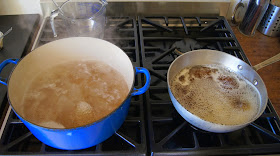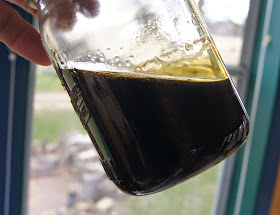 |
| Boiling birch on the left, maple on the right. |
Sugaring season came to an end this week. The birches were running pretty good for a few
days, but with afternoons in the sunny 60s the sap doesn’t keep. The maples slowed and then dried up a good
week ago, and are now breaking bud. I
also tapped our one big black walnut this year, but not soon enough to get much
sap—enough to cook down to maybe a third of a cup, which isn’t bad, considering
I only had about a half gallon of sap.
My minimal experience with black walnut tells me that the sap is at
least as concentrated in sugar as maple, and that it probably
starts running at about the same time.
Since our black walnut tree is always extremely late to leaf out, I had
assumed the sap would run late, too. Not
so.
I took a very low-key approach to sugaring this year. I tapped about five maples, exactly two
birches, and the one black walnut. I
left my half-assed sap contraption in mothballs, and just reduced the sap on
our woodstove, very gradually, and did the final brief boiling on our gas cooktop. The
result was not any great quantity of anything, but the process did produce some
observations.
 |
| Shades of maple: from left, first to fourth boilings of 2015 syrup, and one from 2014 at right. |
The maple syrup was the lightest in color that I’ve ever
made. Even the fourth and final batch,
from sap gathered just before the trees dried up, is medium amber at most—the
last syrup is usually very dark, verging on what sometimes is sold as “grade
B”. So there’s less of a caramel taste
to the maple, but it’s delicious just the same.
 |
| Slow birch 2015. |
The “slow birch” also made a much lighter, more delicate
syrup than hard-boiled versions I’ve done in the past. It's a gorgeous color, reddish mahogany. There’s still an edge of acidity to it, but
it’s rounder, without the aggressive, almost bitter bite of the darker
stuff. I suppose you could liken it to
different roasts of the same coffee bean, from light to Vienna, French, espresso. Actually, I think you could very much liken
it to that. I could see using the
lighter stuff to drizzle over grilled or roasted vegetables, where the darker
version works better combined with other ingredients, in vinaigrettes,
marinades, or glazes.
 |
| Hard-boiled 2014 birch. |
Finally, the walnut.
As I say, I wound up with about half a cup. It’s much more like maple syrup than birch,
which makes sense—maple and walnut trees are more closely related to each other
than they are to birches, aspens, etc.
Also, I believe, though I don’t know for sure, that walnut syrup is
composed of sucrose, as is maple syrup, while birch syrup contains mainly
fructose and glucose. I’m just going
from taste, and common sense(?) on that.
 |
| Black walnut syrup. |
The main thing I was aware of with the walnut syrup was
trying NOT to describe its aroma or flavor as “nutty.” I resisted that characterization mightily,
and in the end, I failed. The finished
product definitely has a slight, but undeniable, aroma of toasted nuts to it,
and a maple-level sweetness.
There you go. That’s
the sugaring report. I think all three
kinds of syrup are worth making if you have access to a few trees. And as with my previous explorations of
micro-batch pickling and preserve making, I hope I’ve shown that you can have
fun with DIY foods without going overboard into tedious mass production. Sometimes a taste is enough.
 |
| Birch in the final reduction. |
Next time it’s on to the nettles and other wild greens. ‘Tis the season. And it’s been mild enough of late that I
think I’ll hit the garden today and plant some radishes, mache, lettuce, and
peas.
 |
| The Bide-A-While tree syrups family portrait, 2015. |

No comments:
Post a Comment